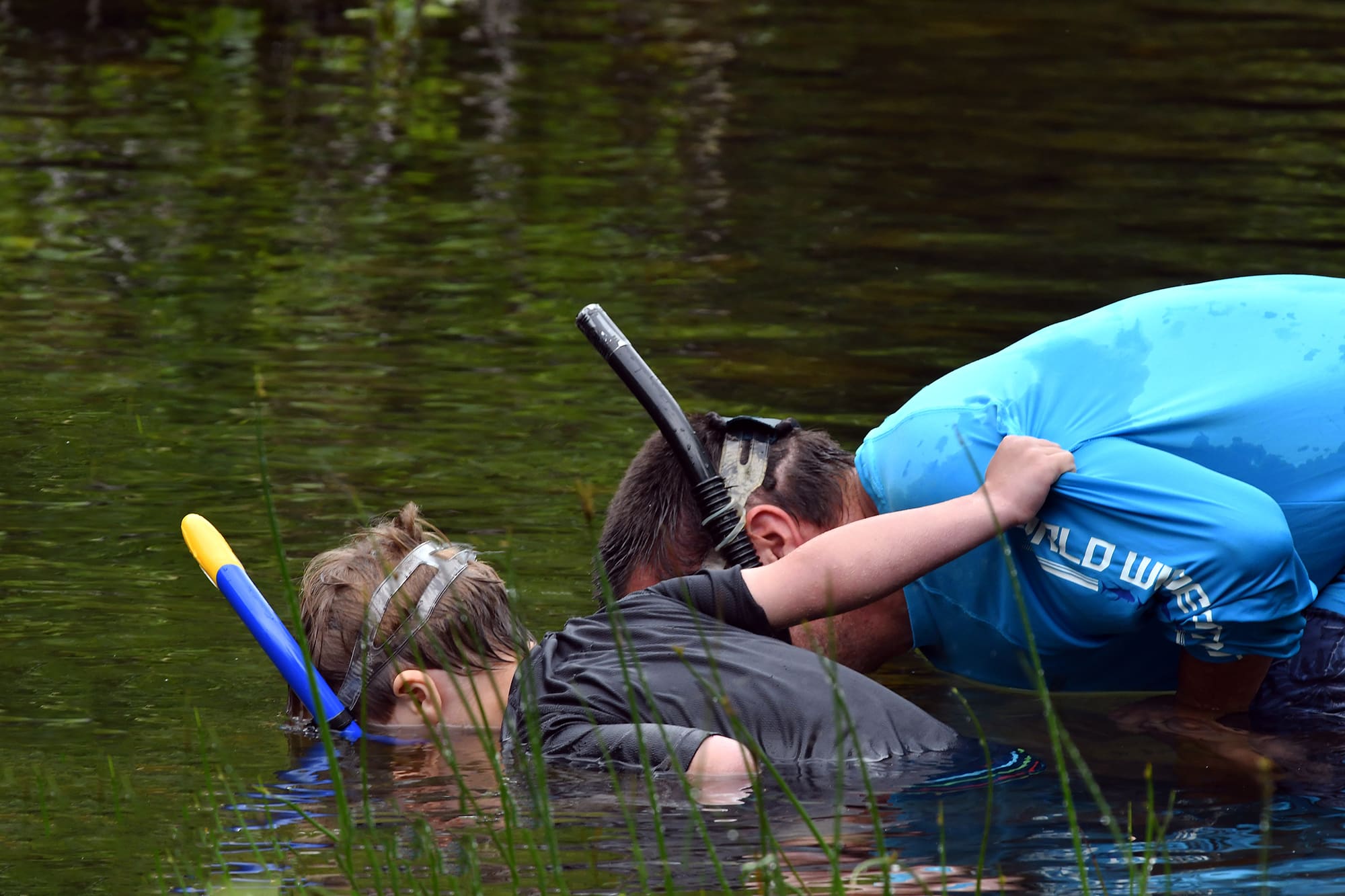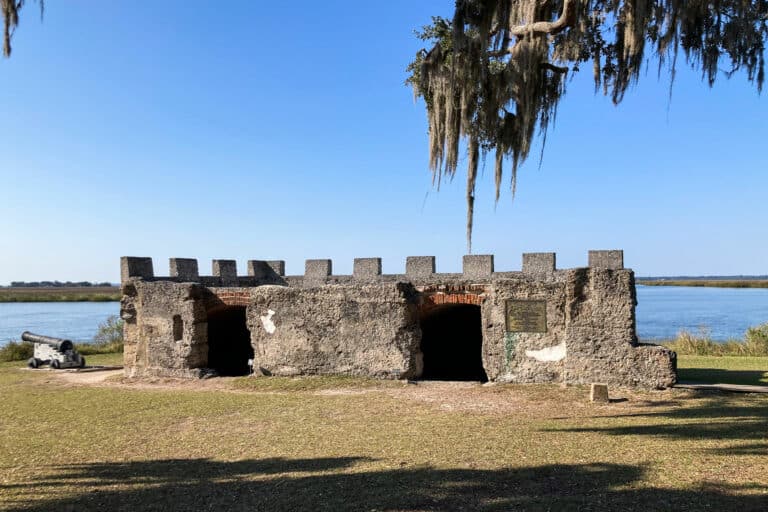What Lies Beneath
Most of our lives, we skim the surface.
When hiking and biking in the forest, we stick to the trails—thin ribbons in a larger, deeper, and wilder landscape.
Similarly, when we paddle a river, we experience only a thin skin of water. But there is a hidden world teeming below our boats.
At first, I thought it was mainly just rocks and a few fish down there. Then I went snorkeling. That’s right: river snorkeling. Snorkeling isn’t just for oceans and coral reefs. In many ways, river snorkeling is even better. Rivers are shallower, which means you are much closer to the critters. And the critters are everywhere.
The rivers of the Southeast are some of the most biologically diverse on the planet. Our waterways are a global diversity hotspot for mussels, salamanders, crayfish, and fish. While most folks come here for the trout—most of which are not native and artificially stocked each year by fish hatcheries—there are 500 other species of fish in Southern streams that you have likely never seen.
Here are four more reasons to consider bringing a snorkel and mask on your next river adventure.
Snorkeling is easy. It requires no special skills. Anyone can do it.
Snorkeling is relatively inexpensive. A basic mask and snorkel cost around $30. If you’re snorkeling in colder Appalachian streams, renting or buying a wetsuit might be worth it.
Snorkeling is badass. Snorkelers often spit on their masks to keep them from fogging up.
Snorkelers are the astronauts of aquatic spaces. Casper Cox calls snorkelers aquanauts: “with a mask of tempered glass you will float free, released from gravity’s pull, drifting though a watery world with quiet ease, exploring new mysteries.”
You can snorkel on your own or with a guide. Guides will show you a lot of the hidden world that your eyes have not yet adjusted to see. Guides will also know the best spots. But a new snorkel trail will help anyone get started.
The Blue Ridge Snorkel Trail
The idea of a Blue Ridge Snorkel Trail was hatched by North Carolina Wildlife Resource Commission biologists Andrea Leslie and Luke Etchison. Both have dedicated a good chunk of their lives to protecting the diversity of species in North Carolina rivers and streams, and two years ago, in the middle of the pandemic, they began brainstorming about ways to introduce more people to the region’s astonishing aquatic diversity.
Most river recreation, such as fishing and boating, brings people above the water. But many of the wonders of western North Carolina streams are under the surface.
“It’s harder to care about something you’ve never seen,” says Etchison. “The more experiences that people have in our streams, the more they will want to protect them.”
So Etchison and Leslie began mapping out a Blue Ridge Snorkel Trail. They partnered with nonprofits including MountainTrue, Mainspring Conservation Trust, and the North Carolina Chapter of the American Fisheries Society to identify 10 unique and spectacular snorkeling sites across Western North Carolina. Educational signs highlighting notable species will be posted at each of these sites, and kick-off events with guided snorkeling are planned for several locations.
Sites include public parks and access spots on beloved and biodiverse rivers, including the Cheoah River, Mills River, Tuckasegee River, Swannanoa River, Pigeon River, and Queen Branch of the Little Tennessee River.
What will you see?
Mussels: Mussels may seem simple—just a shell with a slimy foot. Mussels are blind. Mussels are mostly immobile. They don’t even have a head or brain. Yet they pull off some incredibly complex stunts in the animal kingdom.
For example, how do immobile mussels transport their offspring upstream? They go fishing. Female mussels create elaborate lures with the fleshy parts that stick out of their shells. These lures look exactly like minnows—even though mussels themselves are blind. Unsuspecting fish swim up to the lure, and when the fish bites, the female mussel sprays her larval eggs into the fish’s mouth and gills, where they will grow for a few weeks. Then they drop off the fish miles upstream.
Mussels can also climb to the river bank and “pee” into the water to lure fish. And they are our river’s natural water cleaners: individual mussels filter up twenty gallons of water each day.
The Southeast is home to 269 species of mussels—91 percent of all freshwater mussel species worldwide—with names like monkeyface, snuffbox, rabbitsfoot, heelsplitter, and orange-footed pimpleback.
Fish:
Tourists may come to Southern Appalachia for fall foliage, but aquatic folks know that springtime is the season of color underwater. During the spring mating season, rivers become a riot of color. Male fish display a rainbow of colors to attract females. Outside of the mating season, colorful fish like tangerine darters, warpaint shiners, and redlips darters adorn the rivers. It’s especially thrilling to see brook trout lurking in shaded pools and schools of stonerollers grazing on algae-covered stones.
Crayfish:
The Southeast is the crayfish capital of the world. Unfortunately, populations are plummeting, thanks to dams, pollution, mining, and large-scale agriculture and development. Extinction is looming for half of all crayfish species. Just discovered last year, the Cataloochee crayfish is one of the larger crayfish in the region and is found only in a few rivers around Great Smoky Mountains National Park.
Hellbenders:
You may see the king of North American salamanders and the unofficial mascot of the mountains: the Eastern hellbender. These slimy brown beasts can reach lengths of more than two feet. They breathe through their skin and often shelter beneath large boulders.
The sights are stunning. But snorkeling also expands your other senses. Beneath the thrum of the current, darters talk to each other using underwater knocks, groans, and purrs. Bottom-feeding redhorses’ suction lips audibly pop. River stones clatter. Curious fish acclimate to your presence and swim closer. You become one with the river.
And after a day of snorkeling upriver, there’s nothing better than turning around and floating downstream—face down, dead man’s float, fully alive, and wholly immersed in underwater wonder.
Learn more at blueridgesnorkeltrail.com
Cover photo: Courtesy of Mainspring Conservation Trust








